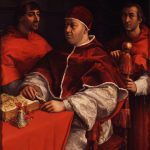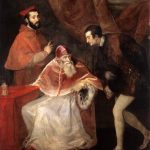This tour will emphasise the importance of Renaissance art patronage with its diverse personal, dynastic, religious, political and cultural agendas. The strong spirit of competition amongst both corporate and individual patrons helped foster some renowned patron-artist relationships and highly innovative artistic approaches.
Corporate patronage included the Papal bureaucracy, the works committees of cathedrals, the guilds and the Republican governments of Siena, Florence and Lucca. Individual patrons came from the prominent families within these structures.
The Medici of Florence
A prime example of individual patronage of the arts is that of the Medici family of Florence, whose rise to prominence from bankers to dukes and popes, was demonstrated through their considerable expenditure on palaces, villas, monastic endowments and the art created to decorate them.
Cosimo ‘il Vecchio’ de’ Medici (1389-1464)
From a successful banking family, Cosimo gradually and subtly ruled Florence from behind the façade of Republicanism, ousting other ruling families like the Strozzi and Brancacci, thus setting the scene for the remainder of the 15th C. He used art as a tool in the establishment of power. Favoured the artists Fra Angelico, Donatello, Michelozzo.
Lorenzo ‘il Magnifico’ de’ Medici (1449-1492, grandson of Cosimo)
Interested in architecture, art theory, poetry, festivals, music, collecting antiquities and manuscripts and Neo-Platonism. Considered an “arbiter of taste”, recommending Florentine artists to patrons elsewhere. Favoured the artists Verrocchio, Pollaiuolo, Botticelli and Giuliano da Sangallo (we will visit his villa, Poggio a Caiano) and Antonio da Sangallo the Elder.
Cosimo I de’ Medici (the first Medici Duke, 1519-1574)
After a shaky start, from 1537 the Medici ruled Florence as Dukes and their patronage became more self-assured and courtly than in the previous century. A proliferation of dynastic portraits and explicit references to imperial rulership is evident in the sculptural and architectural commissions of Duke Cosimo I. This led to the development of Mannerist style through artists like Bronzino, Giorgio Vasari, Benvenuto Cellini, Ammannati and Bandinelli.
Eleonora di Toledo (wife of Cosimo I, 1522-1562)
A Spanish noblewoman, daughter of the Spanish Vice-Roy for Charles V at the Court of Naples. A much more passive patron than her husband Cosimo I, but significant for being a female patron with her own signature style, distinctive for its luxurious courtliness and high degree of sophistication, as well as an astute businesswoman and devout supporter of the Jesuits and charitable foundations. Favoured artists Bronzino (we will see his chapel for Eleonora in the Palazzo della Signoria), Ammannati and Bandinelli.
Papal Patrons: Piety and Power
Pope Pius II (Enea Silvio Bartolomeo Piccolomini, Pope 1458-1464)
Most well-known for the humanist urban planning project in Pius II’s home town of Corsignano, renamed Pienza (city of Pius), which we will visit. This very classicising retreat from the cares of Rome, was commissioned from the Florentine architect Bernardo Rossellino and described in the Pope’s own Commentaries, written shortly before his death.
In the Duomo of nearby Siena, we will visit the Piccolomini Library, with Pinturicchio’s colourful frescoes of the life of Cardinal Enea Silvio Piccolomini (future Pope Pius II) from 1502-07.
Pope Sixtus IV (Francesco della Rovere, Pope 1471-84)
Rebuilt the Sistine Chapel and had the walls frescoed in the early 1480s by prominent Florentine artists.
Pope Julius II (Giuliano della Rovere, nephew of Pope Sixtus IV, Pope 1503-13)
Aimed to rebuild Rome on the scale of the ancients, conveying the image of the Pope as heir to the emperors of ancient Rome. He had the 4th century Old St Peter’s Basilica of Emperor Constantine I demolished to build a new one. A prominent patron of Bramante (“new” St Peter’s and the Vatican Palace), Michelangelo (Tomb of Julius II and the Sistine ceiling) and Raphael (Vatican Stanze). One of the most significant patrons of the Renaissance.
Pope Leo X (Giovanni de’ Medici, first Medici Pope, reigned 1513-21)
A confirmed hedonist, his coronation was among the most extravagant of the Renaissance. Spent lavishly on the arts, including commissioning ten tapestries for the Sistine Chapel (designed by Raphael then woven in Flanders), appointing Raphael Superintendent of Antiquities and commissioning Michelangelo to complete the Medici church of San Lorenzo in Florence.
Pope Paul III (Alessandro Farnese, Pope 1534-49)
A great Church reformer, Paul III’s reign marks the beginning of the Counter Reformation, a response to the threat from Protestantism challenging the Catholic church. As a cardinal, he commissioned Antonio da Sangallo the Younger to design the grand Farnese Palace in Rome. This was later enlarged by Michelangelo. Paul III appointed Michelangelo (then aged 60) Chief Architect, Sculptor and Painter to the Vatican Palace and Michelangelo painted the Last Judgement on the altar wall of the Sistine Chapel at this time.
Cardinal Ippolito II d'Este (1509-1572)
We will visit his magnificent Villa d'Este in Tivoli. Son of Duke Alfonso I d'Este of Ferrara and Lucrezia Borgia (and thus grandson of Pope Alexander VI), perhaps best known for his plunder of nearby Emperor Hadrian’s Villa, transferring antique marbles and statues to decorate his own villa. Also well-known for his failure to become Pope, despite several attempts.











